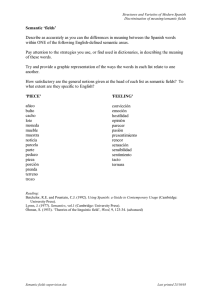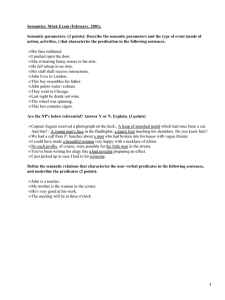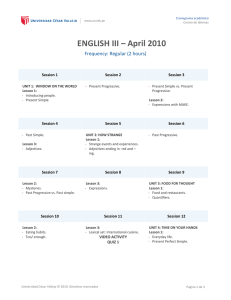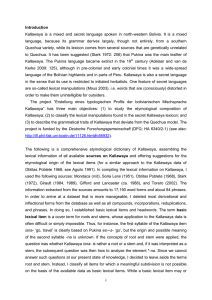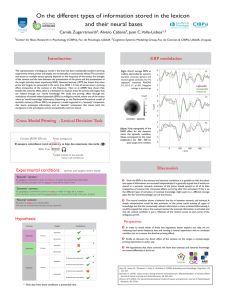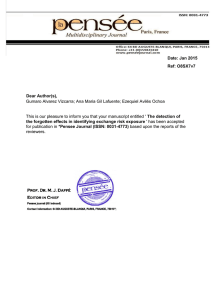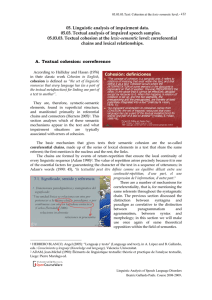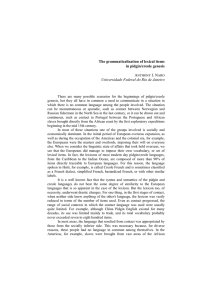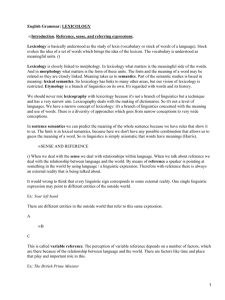The Semantics of Negative Affixation within the Lexical
Anuncio
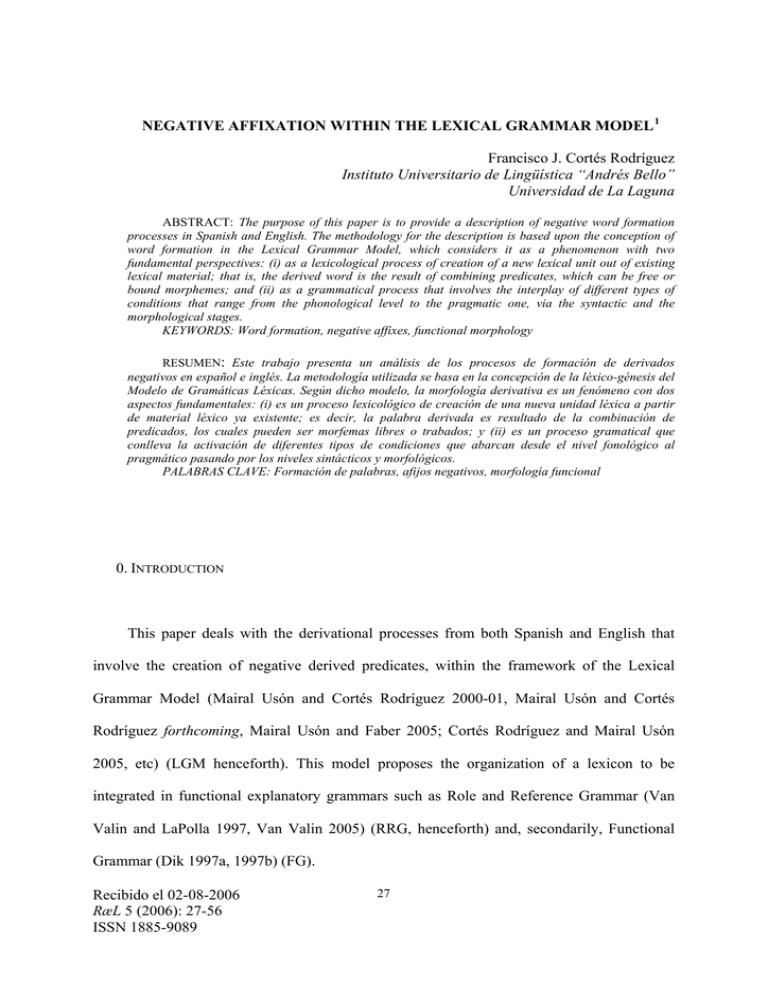
NEGATIVE AFFIXATION WITHIN THE LEXICAL GRAMMAR MODEL 1
Francisco J. Cortés Rodríguez
Instituto Universitario de Lingüística “Andrés Bello”
Universidad de La Laguna
ABSTRACT: The purpose of this paper is to provide a description of negative word formation
processes in Spanish and English. The methodology for the description is based upon the conception of
word formation in the Lexical Grammar Model, which considers it as a phenomenon with two
fundamental perspectives: (i) as a lexicological process of creation of a new lexical unit out of existing
lexical material; that is, the derived word is the result of combining predicates, which can be free or
bound morphemes; and (ii) as a grammatical process that involves the interplay of different types of
conditions that range from the phonological level to the pragmatic one, via the syntactic and the
morphological stages.
KEYWORDS: Word formation, negative affixes, functional morphology
RESUMEN: Este trabajo presenta un análisis de los procesos de formación de derivados
negativos en español e inglés. La metodología utilizada se basa en la concepción de la léxico-génesis del
Modelo de Gramáticas Léxicas. Según dicho modelo, la morfología derivativa es un fenómeno con dos
aspectos fundamentales: (i) es un proceso lexicológico de creación de una nueva unidad léxica a partir
de material léxico ya existente; es decir, la palabra derivada es resultado de la combinación de
predicados, los cuales pueden ser morfemas libres o trabados; y (ii) es un proceso gramatical que
conlleva la activación de diferentes tipos de condiciones que abarcan desde el nivel fonológico al
pragmático pasando por los niveles sintácticos y morfológicos.
PALABRAS CLAVE: Formación de palabras, afijos negativos, morfología funcional
0. INTRODUCTION
This paper deals with the derivational processes from both Spanish and English that
involve the creation of negative derived predicates, within the framework of the Lexical
Grammar Model (Mairal Usón and Cortés Rodríguez 2000-01, Mairal Usón and Cortés
Rodríguez forthcoming, Mairal Usón and Faber 2005; Cortés Rodríguez and Mairal Usón
2005, etc) (LGM henceforth). This model proposes the organization of a lexicon to be
integrated in functional explanatory grammars such as Role and Reference Grammar (Van
Valin and LaPolla 1997, Van Valin 2005) (RRG, henceforth) and, secondarily, Functional
Grammar (Dik 1997a, 1997b) (FG).
Recibido el 02-08-2006
RæL 5 (2006): 27-56
ISSN 1885-9089
27
One of the strongholds of the LGM is its system of semantic representation for
predicates that accounts not only for the lexical semantic relations among the members of the
vocabulary of a natural language, but also triggers a set of linking mechanisms that act as an
interface between the lexicon and the grammatical component. In such a framework,
therefore, lexical analysis and description is fundamental for the organization of the rest of
the grammatical modules.
From its original conception (Martín Mingorance’s Functional Lexematic Model 2 , the
direct predecessor of the LGM) the lexical module includes a Word formation Component,
which is autonomous though interrelated with the rest of the components of the grammar. In
this way, the status of word formation is clearly defined as a grammatical phenomenon that is
not subservient either to the syntactic, the morphological or the phonological modules. The
phenomena of lexical creation are, as Kastovsky’s (1977) paper expresses in its very title, ‘at
the crossroads of morphology, syntax, semantics and the lexicon". Though in the 70s the term
‘interface’ was not so much used in the linguistic literature, the metaphor of the ‘crossroads’
as applied to word formation captures much of the conception proposed nowadays by that
term: lexical derivational products are the result of the activation of processes from different
levels of description (from semantics to phonology via morphology or even pragmatics),
though with their special idiosyncrasies, which makes it inadequate to assimilate word
formation to any of the components of a grammar. This paper addresses the manner in which
all the different components of grammatical description participate –or interface- in the
generation of a derived word.
The first section provides a description of the conception of derivational morphology in
the LGM; this is preceded by a description of the analysis of these phenomena in RRG and
FG. Such a description will reveal important weaknesses in both approaches, and will
Recibido el 02-08-2006
RæL 5 (2006): 27-56
ISSN 1885-9089
28
consider the way to round about them by postulating that word formation is a double sided
phenomenon.
Section 2 offers an explanation of one of the two aspects that are part of the nature of
word formation: derivational morphology as essentially a lexico-semantic phenomenon. This
will be illustrated by analyzing the semantics of the negative affixal class, which includes two
main subclasses: the lexical subclass of oppositive affixes and the subclass of reversatives.
Section 3 will provide a brief description of the different morphosyntactic and
morphohonological processes involved in the generation of a derived word. This will respond
to the other conception of word formation as a grammaticalization of lexical structures.
1. WORD FORMATION IN THE LGM
As advanced above, the LGM is a model of lexical description that seeks to enrich the
structure of the lexicon component in RRG and some similar functionalist models like FG.
Mairal Usón and Cortés Rodríguez (forthcoming) and Cortés and Pérez Quintero (2002)
describe several of the reasons why the treatment of derivational morphology in those
grammatical models does not fully respond to the intricacies of the topic. Both theories
coincide in postulating lexical rules (RRG) and predicate formation rules (FG) to describe
word formation processes.
By way of example, agent nominalizations are described in the following way:
(1) RRG Lexical Rule for Word Formation (Van Valin and LaPolla 1997: 188-189):
verb + -er Æ [N verb + -er] ‘xi which verbs’ ([LS ...(xi, ....) ...]), where ‘x’ is the actor
argument in the logical structure
Recibido el 02-08-2006
RæL 5 (2006): 27-56
ISSN 1885-9089
29
(2) FG Predicate Formation Rule for Agent Noun Formation (Dik 1997b: 3)
input:
output:
meaning:
pred [V, +contr] (x1)Ag/Pos ...(xn) [n≥1]
{Ag pred} [N] (x1)∅ ... (xn)
‘a person who has the property of being (habitually)
involved in the action of pred-ing’
As stated elsewhere (Mairal Usón and Cortés Rodríguez 2000-01: 273-274), these rules
miss important generalizations about the complexities involved in word formation. One
common weakness to the two rules described above is their inefficiency to explain the
following questions:
(a)
they do not include in their input the possibility of creating non-deverbal
formations, both in the case of –er formations (e.g. astrologer, geographer) and of other
agent nouns (e.g. cartoonist, technician); in the case of FG Agent Noun Formation Rule it
also excludes the possibility of forming nouns like sufferer or loser, where the base is [Control].
(b)
in the case of the FG rule, there is no consideration either in the input or the output
of what morphological device will be triggered; that is, nothing refers to the final form that
the {Ag pred} variable will have. Furthermore, it does not explain under which conditions the
output form is monovalent (e.g. writer (x)) or bivalent (e.g. writer (x) (y)) and, in the second
case, under which conditions the second argument will be a postmodifier (e.g. the writer of
this novel ) or a premodifier (e.g. a book writer).
The semantics of both rules is misleading and, furthermore, there is no interrelation
between the meaning and the (internal and external) syntax of the derived word. For instance,
it is not possible to distinguish among competidor (“someone who competes in one (specific)
contest”), fumador (“someone who smokes habitually”), pescador (“someone whose habitual
profession is to fish”) or flotador (“something to help you float in the water”, i.e. a float). (cf.
Cortés 1997).
Recibido el 02-08-2006
RæL 5 (2006): 27-56
ISSN 1885-9089
30
The LGM proposes the study of word formation as a double-sided phenomenon, both as
a grammaticalization of the lexicon (as in Coseriu 1978) and as a lexicalization of
predicational structures, the view that has been adopted by the generative tradition initiated
by Lees (1960) and continued by the Generative Semantics school and, more recently, by
Baker (1988), Borer (1994), Ghomeshi and Massam (1994). The first perspective is
concerned with the semantic relations that hold between the components of a complex
lexeme; i.e., word formation is a lexicological phenomenon. The second considers complex
lexical units as the morphosyntactic expression of a (group of) grammatical relation(s). From
this perspective, word formation can be considered as a syntactic process, usually understood
as the result of a reduction from analytical underlying structures similar to the ones that
represent clauses or phrases. However, the studies located in the lexicalist tradition (initiated
in Chomsky 1970 and continued in Aronoff 1979, Roeper and Siegel 1978, Scalise 1987,
among many others) proved the insufficiencies of adapting derivational morphology to the
syntactic apparatus of a grammar, as the productivity and predictability of word formation
rules make them very different from the much more regular and consistent rules of syntax.
The conjunction of these two perspectives offers a view of word formation as a
systematic process of lexicalization of analytical (predicational) structures subject to a set of
particular conditions, which pertain to all the levels of a grammatical model: phonology,
morphology, syntax, semantics and pragmatics. This process of lexicalization serves the
purposes of creating labels for new conceptual categories, taking as ingredients already
existing lexical material (lexemes and affixes).
There are two types of methodological approach to be carried out in the study of word
formation processes, each of them associated with one of the perspectives just described.
There is an analytical phase which essentially will decode the material of complex lexemes.
This involves examining the phonological, morphological, syntactic and lexico-semantic
31
Recibido el 02-08-2006
RæL 5 (2006): 27-56
ISSN 1885-9089
structure, paying special attention to the type of semantic relation that holds between the
W(ord)-Syntactic Components (see section 2) of the complex lexeme since, as expressed in
Coseriu (1978), the meaning of a complex lexical unit consists of (a) the sum of the meanings
of its components, which is predictable by the application of the word formation rules (their
signification) plus (b) the relation of the linguistic signs with their referents (their
designation).
The output of this analytical phase when applied extensively to the vocabulary of a
language will be an affixal lexicon where lexical units (affixes and word formation patterns)
are organized in semantically coherent classes (in a fashion similar to the organization of the
primary lexicon), and each of those classes and their members will have an adequate
semantic representation in the format of a Lexical Template (see also section 2).
The synthetic phase will account for the succession of processes that are necessary to
generate a complex lexeme; the starting point of this phase is the lexical representations of
the lexical units that participate in the derivational process, which will be subject to the effect
of different types of linking rules; note that this process is conceptually similar in its working
to the derivation of grammatical structures, such as clauses, in productive models of grammar
(see section 3).
2. AFFIXAL NEGATION AS A GRAMMATICALIZATION OF THE LEXICON
In this section we consider word formation from the first perspective, as a relation
between different lexical units in which some type of determination of one over another
holds. This is reflected in the diagram for the WFC in the first linking phase, which takes
place within the lexical component of the grammar (See Appendix 1). That is, the processes
32
Recibido el 02-08-2006
RæL 5 (2006): 27-56
ISSN 1885-9089
of word formation are primarily the result of the fusion between different lexical units .This
fusion is mediated by certain matching conditions between the semantic representations of
the morphemes that are at play; i.e. the base word and the affix, in the cases of derivation.
Such compatibility conditions involve also the interplay of certain semantic redundancy rules
(henceforth SRRs). Redundancy rules were originally proposed by Jackendoff (1975) for
morphological processes, and their more relevant feature was their static character: they
showed the lexical relation that existed between a derivative form and its corresponding base.
Nevertheless, Jackendoff himself admits the possibility of them being truly generative, as
they can be used for the generation of novel, non-lexicalized formations. In a similar vein,
Bybee (1998) proposed that lexical rules in morphology are abstract schemas that capture a
generalization; i.e. express a relationship present in several derivational products. Our use of
SRRs will yield in between a static and a dynamic process: they do reveal lexicalization
patterns present in a number of morphologically complex structures which are formed by a
certain (class of) affix(es). But given the nature of morphogenesis (Hagége 1993), which
involves using these fixed patterns for the creation of novel forms (i.e. they show the paradox
of using old material for creating new one) SRRs are potentially dynamic schemas subject to
more or less constant activation by language users. The frequency of activation of a given
SRR will reveal the degree of productivity it has.
This process focuses then on semantic description and semantic compatibility between
the meanings of the components of a derived word. For a better understanding of the format
of semantic descriptions in the remainder of the paper, let us briefly describe how lexical
decomposition is formulated in the LGM.
The semantic decomposition of predicates within this model is provided in the format of
a Lexical Template (LT) whose design is a compromise between the Aktionsart
characterization of lexical units as proposed in RRG and to a lesser degree in Rappaport and
33
Recibido el 02-08-2006
RæL 5 (2006): 27-56
ISSN 1885-9089
Levin (1998) on the one hand, and the richer semantic description as postulated in the
Functional Lexematic Model (Faber and Mairal 1999) on the other. With regard to the first
aspect, RRG uses a system to represent the semantic structure and argument structure of
verbs and other predicates (their logical structure, LS). It is based on the Aktionsart
distinctions proposed in Vendler (1967), and the decompositional system is a variant of the
one proposed in Dowty (1979); there is also one non-Vendlerian class, namely semelfactives
(Smith 1997). Lexical classes are divided into states, activities achievements, semelfactives
and accomplishments together with their corresponding causatives. States and activities are
primitives (these are marked in boldface plus a prime), whereas accomplishments and
achievements consist of either a state or activity predicate plus a BECOME and an INGR
operator respectively; the non-telic variants of achievements is introduced by the operator
SEML. There are a number of tests which determine which class the verb in a clause is to be
assigned (see Van Valin and LaPolla 1997: 90-128).
The inventory of logical structures formulated within the RRG framework is the
following (Van Valin and LaPolla 1997: 109; Van Valin 2005: 45):
State
Verb Class
Logical Structure
predicate’ (x) or (x,y)
Activity
do’ (x, [predicate’ (x) or (x,y)]
Achievement
INGR predicate’ (x) or (x,y), or
INGR do’ (x, [predicate’ (x) or (x,y)]
SEML predicate’ (x) or (x,y), or
SEML do’ (x, [predicate’ (x) or (x,y)]
BECOME predicate’ (x) or (x,y), or
BECOME do’ (x, [predicate’ (x) or (x,y)]
do’ (x, [predicate1’ (x, (y))] and BECOME
predicate2’ (z,x) or (y)
α CAUSES ß where α, ß are LS of any type
Semelfactive
Accomplishment
Active accomplishment
Causative
Recibido el 02-08-2006
RæL 5 (2006): 27-56
ISSN 1885-9089
34
However, the LGM proposes an enrichment of these logical structures by adding a
semantic characterization, which will permit firstly to organize the lexicon in semantically
coherent classes and hierarchies, and secondly –once it has been assumed (Mairal and Faber
2005) that semantic characterization is done by means of a restricted semantic metalanguage
–a close set of undefinables or primitives- the cross-linguistic validity of the approach is
guaranteed. Such a semantic metalanguage is a combination of Wierzbicka’s Natural
Semantic Metalanguage (Wierzbicka 1987, 1996, Goddard and Wierzbicka 2002), Mel’cuk’s
Text-Meaning Theory (Mel’cuk 1988, 1989, Mel’cuk and Wanner 1996) and the set of
nuclear terms or superordinates of the lexical classes as analyzed in Faber and Mairal (1999:
279-293). Lexical templates have the following format:
[semantic representation] + logical structure = predicate
The first part of the template includes the semantic parameters that differentiate one
predicate form others within the same domain; the second part codifies its event structure and
the set of grammatically salient properties.
The first component is encoded by means of semantic primitives and lexical functions
that are essentially paradigmatic, while the representation of the second component is the
same as RRG logical structures. With regard to the notational conventions, the LGM makes
use of internal and external variables. Internal variables are marked with numerical
subscripts, while external variables are represented by Roman characters.
Thus, according to Mairal and Faber (2005) in the lexical class of cognition verbs in
English, the lexical units are defined on the basis of know, which is the superordinate term in
the whole verbal domain. The various hyponyms of know are generated by applying
Mel’cuk’s Lexical Functions to them; for example, the representation of the verb fathom
would be the following:
Recibido el 02-08-2006
RæL 5 (2006): 27-56
ISSN 1885-9089
35
(3) fathom:
[MAGNOBSTR & CULM1,2[all]] know’ (x, y)
The entry in (3) is composed of: (i) the semantic component in brackets; (ii) the
representation of the logical structure. This predicate is given in the form of a state logical
structure which takes know’ as a primitive and has two arguments. Furthermore, this logical
structure is in turn modified by a lexical function (or operator), MAGNOBSTR, which refers
to the difficulty involved in carrying out an action, and in the case of fathom, there is great
difficulty. As shown in (3), lexical inheritance allows the packaging of enriched lexical
information into one unified format since the hyponyms inherit the properties of their
superordinate terms.
One important assumption of the LGM is its conception of the lexicon as composed of
lexical morphemes of two types, free lexical morphemes –or words- and bound lexical
morphemes –derivational affixes-; both free and bound morphemes will be semantically
represented by means of their corresponding lexical template (LT). In the following sections
there are detailed descriptions of the LTs that encode the semantic content of the class of
affixal negative predicates.
2.1. Oppositives
Negation is a universal feature, as all languages have means for expressing the notion of
opposition, and many exhibit this meaning by means of morphological exponents. Thus, In
English there is a class of affixal units which includes, among others, un-, dis-, a-, non-, in-,
anti-, etc. and in Spanish in-, des-, contra-, a-, etc. Their semantic function is to produce
lexical negatives or antonyms. However, antonymy is not a simple phenomenon, as it
36
Recibido el 02-08-2006
RæL 5 (2006): 27-56
ISSN 1885-9089
includes different types of meaning opposition. At least there are two ways of codifying
negativity: by expressing the lack of properties or attributes of an entity (then, we may speak
of cases of contradictoriness or privativity), or by expressing opposing features or attributes
of entities (cases of contrariness) 3 . Contradictory terms constitute binary pairs of the type
live/dead, whereas contrary terms allow for gradable properties as in hot/warm/cool/cold (for
detailed descriptions of (non)gradability and negation cf. Lyons 1977: 281ff.; Kastovsky
1982; Cruse 1986: Chapters 9-11; Saeed 1997: 66-68, among many others).
Affixal negatives exhibit these two types of meaning opposition, which are encoded in
the following templates:
(4) ϕX: ANTICOMP[LT (x <ϕBASE>)] E.g. non-moral, amoral
(5) ϕX: ANTI [LT (x <ϕBASE>)] E.g. immoral
Due to their universal character, the templates encode the meaning in terms of two
Lexical Functions, ANTI and ANTICOMP, extracted from Mel’cuk and Wanner’s (1996)
inventory and Alonso and Tutin’s (1996) modifications to the inventory, respectively.
ANTICOMP is to be understood merely as a function that encodes complementary antonymy
and, therefore, has an absolute non-gradable (i.e. binary) value (cf. Alonso Ramos and Tutin
1996: 152), whereas contrary values are encoded by ANTI; i.e. it involves a negative value
along some scalar standard; thus, negativity is as long as it is compared with the value(s) of
the attributes expressed by the base word. The function ANTICOMP, on the other hand, merely
states the absence of such (an) attribute(s).
There is a subtype of the contradiction template, in which the operator ANTI is
semantically modified by a temporal lexical function:
Recibido el 02-08-2006
RæL 5 (2006): 27-56
ISSN 1885-9089
37
(6) ϕV: [LTLOCin temp ← ] ANTI [LT (<ϕBASE>)]
This variant of the original template is necessary to explain the meaning of those
formations that involve the cessation of an event (disusev, discontinue ‘to use/continue no
longer’) or of a property or condition: (descreer, disbelieve ‘not to believe any more’). That
is, these prefixed formations presuppose the occurrence of these states of affairs in some
previous time-span.
Another interesting feature of this class concerns its internal structure; the templates
above involve a major division into two subclasses; affixes are distributed along this major
division between the contrary-negative and the contradictory-negative subclasses, thus having
one group of exclusively contrary affixes (counter-, anti-, e.g. antibody, anticommunist,
counter-irritant, countertenor), another of exclusively contradictory ones (a-, non- formations
e.g. amoral, achromatic, non-metal, non-smoker) and a third group with both values (in-,dis-,
un- e.g. invisible, inactive, infertile vs. immoral, inhuman; unavailable, unbeliever, unborn
vs. unclean, unsmooth, unperson, unfrequented; distrust, disbelieve, discommodity vs.
dissimilar, disharmonious, disapproval, distasteN ).
One interesting case of overlap between classes concerns the relation between the
contrariness-as-opposition meanings and the locative class.
The notion of contrariness, expressed in (5) by means of the Lexical Function ANTI,
can be further divided into more specific semantic values, as is shown for instance by the
formations with the affix anti- not only in Spanish or English, but also in other languages like
Old Greek, where the origin of the affix lies. There are formations from that period –some of
which still are present in Modern Greek and in other contemporary languages- where the
meaning of opposition is clearly seen as a development from a locative meaning (‘be-infront-of’: Ant-artic; Anti-kythira –the name of the Greek island that is in front of the island
38
Recibido el 02-08-2006
RæL 5 (2006): 27-56
ISSN 1885-9089
called Kythira, which by the way is bigger than the other); the conceptual development is
schematically as follows: what is located in front of an entity is seen as an obstacle, and
obstacles are opposed to the entity; there is also the implication of (a)symmetry: what
opposes to something is somehow similar to it and somehow dissimilar at the same time: an
anti-novel is contrary to a novel being a novel at the same time, or an anti-hero is the contrary
of a hero; however, not any character is an anti-hero as it must have some ‘heroic’ attributes
though in an insufficient or adequate degree (cf. Cortés and García Gálvez 1990); Sosa
Acevedo (2001, 2005) provides a detailed explanation of the semantic relations among the
different values of prefixes. The following diagram illustrates the different values of the
prefix anti- that are derived from the original template:
ϕX: ANTI [[LT (x <ϕBASE>)]
SRR: ANTI [BE like’(x <ϕBASE>)] CULM ANTI [BE against’(x, y <ϕBASE> ))]
Sem.Rel: asymmetry
opposition
I-Syntax: anti# ϕX
E.g.: anti-pope, antinovel
anti# ϕX
antifascist, anticapitalist
A more recent development in the meaning values of this affix –and others of the
contrary class- is the one present in formations like anti-dandruff, anticorrosion, with clear
causative nuances, thus leading us to another transition zone between the negative class and
the reversative one, in this case. It seems logical to consider that the source for the causative
Recibido el 02-08-2006
RæL 5 (2006): 27-56
ISSN 1885-9089
39
formations is the opposition value. The semantic transition implicit in these formations can be
captured by the following scheme:
(7) ϕX: ANTI [[LT (x <ϕBASE>)]
Æ CULM ANTI [BE against’(x, y <ϕBASE>))]
ÆÆ do’( x, ∅) CAUSE [ANTI EXIST (y <ϕBASE>)]
ÆÆÆ do’( x, ∅) CAUSE [NOT EXIST (y <ϕBASE>)]
2.2. Reversatives
As can be deduced from the above representation the subclass of reversative formations
lies in an overlapping area between negative formations and causative verbalizations (where
English affixes like –ize,-ate,-en, etc. belong). This is reflected in the format of the maximal
template for reversative formations:
(8) ϕV: [LTLOCin temp ← ] do’(x, ∅) CAUSE [ANTI [LT]] 4
For a better understanding of this type of processes, let us consider the general template
for causative deverbal formations:
(9) ϕV: do’(x, ∅) CAUSE [LT]
The formula in (9) encodes a complex semantic structure in which there is causal bond
between two subevents, the induced one corresponding to a state of affairs in which the base
Recibido el 02-08-2006
RæL 5 (2006): 27-56
ISSN 1885-9089
40
word is involved or affected more or less directly. That is, as a subclass of verbalizations the
function of causative affixes is to build up a predicational structure around the LS of a(n)
(potential) argument. A verb like Spanish enlatar is the output of a causative locative
template such that the base noun lata is enmeshed in a semantic scenario as a locus for the
placement of some other entity (see 13 for the representation of the reversative equivalent
formation destronar). Thus the derived formation takes the base noun as a pillar around
which to build up an event. The locative meaning is determined by the semantic
characterization of the noun –specifically its Formal and Telic Qualia characterization
(Pustejovsky 1995) 5 - and the SRRs that would read this characterization and impose a
definite interpretation of the template. The reversative template also yields different
interpretations similar to the ones for causatives, which makes it feasible to postulate that
they result from the interaction of SRRs whose scope of application seems to range the whole
class of verbalizations 6 ; in fact, there are at least the following three rules that can be applied
to the basic reversative template (8) when combined with different base words:
(10) SRR1: [LT] Æ BE-LOC (x, ϕBASE)
(11) SRR2: [LT] Æ BE-LOC (ϕBASE,y)
(12) SRR3: [LT] Æ BECOME/BE pred’ (ϕBASE)
Rules SRR1 and SRR2 account for those cases where the derived formations have
locative interpretations; i.e. there is a combination of three basic parameters: causativity +
negativity + location; whereas the two first semantic primitives are criterial for the
delimitation of the affixal classes to which reversatives belong (in other words, they are part
of the meaning characterization of the morphemes that constitute the class), the last one –
Recibido el 02-08-2006
RæL 5 (2006): 27-56
ISSN 1885-9089
41
location- is motivated by the semantic characterization of the bases. Their Qualia
characterization (formal and/or telic) provides the contextual feature that triggers this
reading: these nouns typically have the form or the function of containers, involving a
locative relation with respect to another entity, and therefore the rule to be applied is SRR2
above. On some occasions, the base noun is the locandum/theme argument, as it is also
involved by some of its Qualia features, and the rule that is at work then is SRR1 above; the
following examples illustrate both possibilities:
(13) destronarV :
/des#/ ϕN /Ø/V: [BE-LOC2,3LOCin temp ← ] do’(x, ∅) CAUSE [ANTI [LT]] + tronoN: throne’ (x
< {… QFORMAL: seat’ (x,y) QTELIC: [BE on’ (trono,y)]…}>)
Æ SRR : [LT] Æ BE-LOC ϕBASE,y).
Æ Semantic Relation: Location: [BE-LOC (y <ϕN>, z)]
Æ Syntaxeme’s realization: Illative : BE-LOC > BE-on’
ÆÆOUTPUT: destronarV: [BE-LOC2,3LOCin
on’(tronoN, z)]
temp ←
] do’( x, ∅) CAUSE [ANTI ]BE-
(14) descamar :
[/des#/ ϕN /Ø/V ]V: [BE-LOC2,3LOCin temp ← ] do’(x, ∅) CAUSE [ANTI [LT]] + escamaN: (x <
{… QFORMAL: be-on’/around’ (x,y)…}>)
Æ SRR : [LT] Æ BE-LOC (y, ϕBASE).
Æ Semantic Relation: Locandum/Theme: [BE-LOC (y, z <ϕN>)]
Æ Syntaxeme’s realization: Superpositive/Circumlative : BE-LOC > BE on’/around’
ÆÆOUTPUT: descamarV: [BE-LOC2,3LOCin
on’/around’( y, escamaN)] 7
Recibido el 02-08-2006
RæL 5 (2006): 27-56
ISSN 1885-9089
temp ←
42
] do’( x, ∅) CAUSE [ANTI ]BE-
With regard to the operator LOC, it must still be specified for specific dimensional
values. Such values are considered variants of a ‘syntaxeme’, as defined by Mukhin and
Yulikova (1991: 291):
[…] an elementary syntactic unit (an invariant) represented in the language by a system of
variants, which may be expressed by both individual lexemes and syntactically indissoluble
combinations of lexemes with auxiliary elements, e.g. prepositions. The content of a syntaxeme is
formed by its syntactico-semantic features which manifest themselves by the distributional
characteristics of the syntaxeme, as well as by its specific system of variants.
SRR3 in (12) accounts for formations where the fusion with the bases yields an
adscriptive/attributive reading, as in the following formations: defrost, decentralize,
demagnetize, unsanctify, decontaminate. The semantic representation for these derived verbs
is as follows:
(15) ϕV: [BE-pred’2LOCin
<ϕBASE>)]
temp ←
] do’( x, ∅) CAUSE [BECOME/BE ANTIpred’ (y
The effect of the overlap with the negative class can be seen in the necessity on most
occasions of adding a semantic specification that refers to a temporal modification ([BELOC/ pred’22,3LOCin
temp ←
]): the implication is that the reversative effect presupposes a
previous contrary state of affairs; hence, a formation like decentralize means not just ‘to
cause to be not central’ but ‘to cause to be no longer central’. There are, however, a minority
of formations that may not imply such semantic specification, as in the case of unbarbarize
(cf. Kastovsky 2002: 100).
Recibido el 02-08-2006
RæL 5 (2006): 27-56
ISSN 1885-9089
43
Once the fusion process between a base morpheme and an affixal morpheme takes
place, the output will be the fully specified semantic representation of a new derived lexeme.
This representation will be the input to trigger the second phase of the linking process, which
accounts for the generation of a morphologically complex structure whose components show
some type of syntactic connection and are subject to certain morphological and
morphophonological conditions. This process corresponds to the other view of word
formation within the LGM, i.e. word formation as a lexicalisation of grammatical structures.
The next section deals with theses issues.
3. THE SEMANTICS-TO-GRAMMAR INTERFACE
The second phase of linking within the word formation component in the LGM takes as
input the fully specified semantic representation and produces the adequate morphosyntagmatic structure of the derived word. This is achieved by means of two sets of rules:
• W-Syntactic rules, which will account for the internal grammatical configuration of
the predicate, and
• S-Syntactic rules, which will explain its external syntagmatic structure.
W-Syntactic rules stipulate which elements of the underlying representation will be
marked as Determinant (DT) and Determinatum (DM) components. The internal structure of
a word can be described as a grammatical syntagma in which “the determinatum is that
element of the syntagma which is dominant in that it can stand for the whole syntagma in all
positions” (Marchand 1969: 11-12), being the Determinant a modifier of the Determinatum.
Recibido el 02-08-2006
RæL 5 (2006): 27-56
ISSN 1885-9089
44
The assignment of these functions to the elements in the LT of a derived word will
predict the functional structure of the word; following Martín Arista (2006), the Layered
structure of the Word would be as follows:
Recibido el 02-08-2006
RæL 5 (2006): 27-56
ISSN 1885-9089
45
(16)
WORDα
COREα
NUCLEUSα
PREDICATEα
NUC OPERATORS
NUCLEUS
CORE OPERATORS
CORE
WORD OPERATORS
WORD
There are some important differences with Martín Arista’s proposal: his proposal
considers that the NUC node of a complex word is either a bound stem or a free from. Thus, a
word like Old English bocere (“writer”, “instructor”) has the following structure:
(17)
COMPLEX WORDN
COREN
NUC
ARGN
WORDN
COREN
NUCLEUSN
Recibido el 02-08-2006
RæL 5 (2006): 27-56
ISSN 1885-9089
46
boc
ere
The LGM approach considers that the Nucleus of a derived word is the constituent
which perlocates its features in the structure; feature perlocation is associated to the
Determinatum function; thus, the structure of writer would be as follows:
(18)
COMPLEX WORDN
COREN
ARG
WORDv
COREv
NUCLEUSV NUCLEUSN
writeV/DT
erN/DM
This analysis is based on the semantic nature of the process: Actor nominalizations are
processes that build up a referential structure from one of the arguments present in the LT of
the base; however, the nominalized element is not an argument in the morphological
structure, as it becomes the lexical component with predominating grammatical import on the
overall structure of the complex word. This involves also that within the LGM framework
affixation does not entail subordination or any kind of nexus relation, as proposed by Martín
Arista (2006) 8 . In this type of formations the only case of a special juncture relation will
occur with synthetic compounds of the type watch-maker (Marchand 1969: 15-17), whose
structure is as follows:
Recibido el 02-08-2006
RæL 5 (2006): 27-56
ISSN 1885-9089
47
(19)
COMPLEX WORDN
COREN
ARG
WORDN
WORDv
COREN
COREv
NUCLEUSN NUCLEUSV NUCLEUSN
watchN/DT
makeV/DT
erN/DM
In Cortés and Mairal (2000-01: 286) 9 it is explained that there is one interesting
condition in synthetic Actor compounds; the ARG is incorporated as a secondary
determinant, and therefore as a constituent within the structure of the complex word only if it
is a non-referential argument. 10
The other aspect in Martín Arista’s proposal that seems debatable is the status of
affixes; he considers them as operators either at nucleus or core level, depending on whether
they can be attached to derived bases or not. Despite this, in his analysis of agentive
formations (see 17 above) the suffix is part of the constituent projection. Nevertheless, he
proposes a classification of affixes in which, by way of example, causative morphemes are
treated as nuclear operators, and negative affixes are either nuclear (internal negation) or core
operators (logical negation). From the LGM perspective, derivational affixes are to be treated
as elements in the constituent projection and not as operators, since they are predicates and as
such they convey lexical meaning. Let us recall that operators within the RRG model are
linguistic elements with grammatical meaning. At the morphological level the distinction
between lexical and grammatical meanings draws the line between derivational and
inflectional processes. In the previous section it has been shown that negative derivation
48
Recibido el 02-08-2006
RæL 5 (2006): 27-56
ISSN 1885-9089
involves certain complexities of meaning that are only logical insofar as we are dealing with
a lexical class; thus, a form like immoral should be better analyzed as follows:
(20)
COMPLEX WORDN
COREN
AAJ
WORDN
COREN
NUCLEUSADV
inADV/DT
NUCLEUSN
moralA/DM
One interesting feature of the structure of immoral is that it also reveals the status of
prefixes in our model. As Marchand (1969: 134-136) states, prefixes are determinants of
expansions with either adjectival or adverbial force; i.e. the nucleus of a prefixed word will
be the base, provided that its features are the ones that percolate in the structure. The prefix,
in our view, is better analyzed as an argument-adjunct in the constituent projection. This is its
status even in cases of parasynthetic formations like reversatives (encage, delouse, etc),
where the prefix is also part of the determinant, together with the base word, being the
determinatum either a suffix or a conversion process on the base.
After the application of W-Syntactic rules, S-Syntactic Rules are activated to finally
determine the combinatorial behavior of the word in its immediate syntagmatic context, the
NP. In Cortés and Mairal (2000-01: 287-289) there is a description of the effect of S-syntactic
rules within the class of Agentive formations, where the S-Syntactic behavior of the derived
word is essentially determined by Macrorole Assignment in terms of the Actor-Undergoer
Recibido el 02-08-2006
RæL 5 (2006): 27-56
ISSN 1885-9089
49
Hierarchy 11 . The most typical case happens when the second argument of the LT of a base is
referential, and consequently it is blocked for determinant status at W-syntactic level;
however, at S-syntactic level it is a good candidate for Undergoer assignment, which will
determine its appearance as a PP postmodifier within the Core of the NP structure, as in the
following structure which corresponds to the NP “the driver of that taxi”:
(21)
NP
COREN
NUCN
ARG
REF
PP
COMPLEX WORDN
CORE
ARG
WORDV
NUCN
of
COREV
NUCV
NP
COREN
AFFIXN
NUCN
REF
S-Syntax:
W-Syntax:
UNDERGOER
DT
DM
ϕiN:[do’(#eriN##,[ driveV (#eriN##, that taxi)
Recibido el 02-08-2006
RæL 5 (2006): 27-56
ISSN 1885-9089
50
4. CONCLUSIONS
The LGM conception of the lexicon as an organized storehouse of lexical units arranged
in terms of semantic, grammatical and cognitive relations involves an exhaustive and highly
explanatory approach to the analysis of both the primary and the derived lexicon. In the case
of word formation, it involves a study in two phases: (i) a lexicological analytical phase that
explores the semantic intricacies related to the process of combining lexical units for the
production of a new one; the meaning of the coinage is motivated by the meanings of its
component parts; nevertheless, motivation is not equivalent to amalgamation of meanings, as
has been demonstrated with regard to negative affixation in the second section of this paper;
(ii) the synthetic phase considers word formation from a grammatical perspective; section 3 is
a brief example of how complex can be the intertwining of grammatical functions both within
and without the word level when dealing with morphologically complex structures.
The fact that both types of approaches must be dealt with for a full description of what
lies behind the creation of a new lexeme reveals the adequacy of the LGM approach to word
formation and makes it a powerful tool for the description of this kind of processes.
Recibido el 02-08-2006
RæL 5 (2006): 27-56
ISSN 1885-9089
51
Appendix 1: The Word formation Model
Word formation
Templates:
Affixal Classes
Linking I
SRRs
Fusion
Fully Specified
Underlying
Representations
Fusion
Linking II
W- and SSyntax
Morphosyntagma
Expression
Rules
Derived
Word
Recibido el 02-08-2006
RæL 5 (2006): 27-56
ISSN 1885-9089
52
Fund
Base
Words
NOTES
1
Financial support for this research has come from the Research Project HUM2005--07651-C02-01, funded by
the Spanish Ministry of Education.
2
See Marín Rubiales (1998) for a compilation of Martín Mingorance’s works.
3
The terms contrary and contradictory are taken from Zimmer (1964: 21ff.).
4
Joe and Lee (2006) analyze the differences between two types of ‘removal’ predicates, those whose meaning
involves one absence-state and those labelled removal-process by them. The first group includes adjectives like
free from, clear, of, regardless of, and the second group includes verbs such as remove, destroy, erase. It seems
logical that reversatives would belong to the second group. The features of removal process predicates (they are
neither monotone decreasing, nor nonveridical in a strict sense) seem to favour the selection of the LF ANTI in
their corresponding template; ANTIcomp would correspond to the negative meaning of statal (monotone
decreasing and anti-additive) predicates.
5
RRG makes use of Pustejovsky’ s Qualia Theory for a characterization of the semantic properties of nouns.
The Qualia representation of Spanish lata (‘can’) includes: can’:Qconstituive: metallic’ (x), Qformal:
container’ (x,y) Qtelic: [BE in’ (x,y)])], Qagentive:[artifact’ (x ∨ y).
6
English and Spanish verbalizations are vast affixal classes that include several subtypes with many
interrelations and overlapping areas; among these subclasses are, at least, causatives, inchoatives, reversatives
and –partly- privatives and locatives.
7
Following Kastovsky (2002: 99-101) it is possible to establish a parallelism with the rest of causatives with
regard to the possible interpretations of some of the reversative- locative formations as reversative-privative;
e.g. delouse may be interpreted not only as ‘cause louse not be on entity’ but also ‘cause entity not have louse’).
The alternative representation would be: [HAVE2,3LOCin temp ← ] do’( x, ∅) CAUSE [ANTI]have’ (y, z)]. For
him, some are clearly privative, like behead, whereas others like disarm have both a privative and a locativereversative interpretation. The privative reading can be understood in our proposal as the output of another SRR
that substitutes the variable [LT] with the primitive HAVE.
8
Van Valin and LaPolla (1997: 495-497) have a similar interpretation: they propose to interpret compounds of
this kind as cases of nuclear juncture without any nexus contrast at the nuclearN level.
9
Note, however, that this analysis differs from the one in Cortés and Mairal (2000-01), where there is no
description of the internal structure of complex words in terms of the layered structure of the word proposed by
Martín Arista (2006), but a description following only the structure for NPs in Van Valin and LaPolla (1997).
10
Non-referential or inherent arguments are defined in Van Valin and LaPolla (1997: 123) as “an argument
which expresses an intrinsic facet of the meaning of the verb and does not refer specifically to any participants
in an event denoted by the verb; it serves to characterize the nature of the action rather than to refer to any of the
participants”.
11
The S-syntactic behavior of negative affixes is null, as derived negative formations would not show any
special behavior at this level.
5. REFERENCES
Alonso Ramos, M. and A. Tutin. 1996. “A classification and description of lexical functions
for the analysis of their combinations”. Lexical Functions in Lexicography and Natural
Language Processing. Ed. L. Wanner. Amsterdam/Philadelphia: John Benjamins. 146-167.
Aronoff, Mark 1979 (1976). Word Formation in Generative Grammar. Cambridge,
Mass./London: The MIT Press.
Baker, M. 1988. Incorporation: A Theory of Grammatical Function Changing. Chicago:
Chicago University Press.
Recibido el 02-08-2006
RæL 5 (2006): 27-56
ISSN 1885-9089
53
Borer. H. 1994. “The projection of arguments”. Functional Projections. University of
Massachusetts Occasional Papers in Linguistics. Eds. E. Benedicto and J. Runner. Amherst:
University of Massachusetts. 19-47.
Bybee, J. 1998. “The emergent lexicon”. CLS 34: The Panels. Chicago: Chicago Linguistics
Society: 421-435.
Chomsky, N. 1970. “Remarks on nominalization”. Readings in English Transformational
Grammar. Eds. R. Jacobs and P. Rosenbaum. Waltham, Mass.: Ginn and Co. 184-221.
Cortés Rodríguez, F.J. and I. García Gálvez. 1990. “Contrastive analysis and evolution of the
prefix anti- (Ancient Greek, Latin, Modern Greek, Spanish and English)”. Paper delivered at
the 9TH World Congress of Applied Linguistics. University of Thessalonica.
Cortés Rodríguez, F.J. 1997. La Creación Léxica. Una Aproximación Funcional. Universidad
de La Laguna : Servicio de Publicaciones.
Cortés Rodríguez, F.J. and M. J. Pérez Quintero. (2002). “On the syntax-semantics interface
in word formation: the case of English –er nominalizations”. New Perspectives on Argument
Structure in Functional Grammar. Eds. R. Mairal and M.J. Pérez Quintero. Berlin and New
York: Mouton de Gruyter. 213-246.
Cortés Rodríguez, F.J. and R. Mairal Usón. 2005.”La formación de palabras, de nuevo, como
encrucijada: la interfaz semántica-morfología-sintaxis-fonología en el Modelo de Gramáticas
Léxicas”. Algunos Problemas de la Descripción Sintáctico-Semántica. Eds. Cuartero Otal, J.
and G. Wotjak. Berlín: Frank and Timme. 159-174.
Cruse, D.A. 1986.Lexical Semantics. Cambridge: Cambridge University Press.
Dik, S. 1997a. The Theory of Functional Grammar: The structure of the clause. Berlin:
Mouton de Gruyter.
Dik, S.1997b. The Theory of Functional Grammar: Complex and derived constructions.
Berlin: Mouton de Gruyter.
Dowty, D. 1979. Word Meaning and Montague Grammar. Dordrecht: Reidel
Faber, P. and R. Mairal 1999. Constructing a Lexicon of English Verbs. Berlin: Mouton de
Gruyter.
Goddard, C. and A. Wierzbicka. 2002. Meaning and Universal Grammar: Theory and
empirical findings. Amsterdam/Philadelphia: John Benjamins.
Recibido el 02-08-2006
RæL 5 (2006): 27-56
ISSN 1885-9089
54
Gomeshi, J. and D. Massam. 1994. “Lexical/syntactic relations without projection".
Linguistic Analysis. 24: 175-217.
Hagegé, C. 1993. The Language Builder. An Essay on the Human Signature in Linguistic
Morphogenesis. Amsterdam/Philadelphia: John Benjamins.
Jackendoff, R. 1975. “Morphological and semantic regularities in the lexicon”. Linguistics
51: 639-671.
Joe, J. and C. Lee. 2006. “A ‘removal’ type of negative predicate”.
Semanticsarchive.Net.(Available at http://semanticsarchive.net/Archive/DczODk5M/).
Kastovsky, D. 1977. “Word-formation, or: At the crossroads of morphology, syntax,
semantics and the lexicon”. Folia Lingvistica 10: 1-33.
Kastovsky, D. 1982. “Word-formation: a functional view”. Folia Lingvistica 16: 181-198.
Kastovsky, D. 2002. “The derivation of ornative, locative, ablative, privative and reversative
verbs in English: A historical sketch”. English Historical Syntax and Morphology. Eds. T.
Fanego, M.J. López-Couso and J. Pérez-Guerra. Amsterdam/Philadelphia: John Benjamins.
99-110.
Lees, R.B. 1960. The Grammar of English Nominalizations. Bloomington, Ind.: Research
Center in Anthropology, Floklore and Linguistics.
Lyons, J. 1977. Semantics. Cambridge: Cambridge University Press.
Mairal Usón, R. and F. J. Cortés Rodríguez. forthcoming. “Rethinking lexical representation
in Role and Reference Grammar”. The English Lexicon: Structure and Genesis Ed. D.
Kastovsky. Berlin and New York: Mouton de Gruyter.
Mairal Usón, R. and F. J. Cortés Rodríguez. 2000-01. “Semantic packaging and syntactic
projections in word formation processes: the case of agent nominalizations”. Revista
Española de Lingüística Aplicada 14: 271-294.
Mairal Usón, R. and P. Faber. 2005. “Decomposing semantic decomposition. Towards a
semantic metalanguage in RRG”. Lecture delivered at the 2005 Role and Reference
Grammar International Conference. Taiwan. (Available at http:// linguistics. buffalo. edu/
research/rrg/MairalRRG05.pdf).
Marchand, H. 1969 (1960). The Categories and Types of Present-Day English WordFormation.
A
Synchronic-Diachronic
Approach.
München:
Beck’sche
Verlagsbuchhandlung.
Martín Arista, J. 2006. “Derivation and compounding in a structural-functional theory of
morphology”. Lecture delivered at the Meeting of the Danish Group of Functional Grammar.
University of Copenhagen.
Recibido el 02-08-2006
RæL 5 (2006): 27-56
ISSN 1885-9089
55
Mel’cuk, I. 1988. “Semantic description or lexical units in an explanatory combinatorial
dictionary: Basic principles and heuristic criteria”. International Journal of Lexicography 1
(3): 165–188.
Mel’cuk, I. 1989. “Semantic primitives from the viewpoint of the Meaning-Text Linguistic
Theory”. Quaderni di Semantica 10 (1): 65–102.
Mel’cuk, I. and L. Wanner. 1996. “Lexical functions and lexical inheritance for emotion
lexemes in German”. Lexical Functions in Lexicography and Natural Language Processing.
Ed. L. Wanner. Amsterdam/Philadelphia: John Benjamins. 209-278.
Mukhin, A. M. & N. M. Yulikova. 1991.”Locative valency of the English verb: a historical
approach”. Historical English Syntax. Ed. D. Kastovsky. Berlin and New York: Mouton de
Gruyter. 291-301.
Pustejovsky, J. 1995. The Generative Lexicon. Cambridge MA: The MIT Press.
Rappaport Hovac, M. and B. Levin. 1998. “Building verb meanings”. The projection of
arguments: Lexical and compositional factors. Eds. M. Butt and W. Geuder. Stanford: CSLI.
97-134.
Roeper, T. and M. Siegel. 1978. “A lexical transformation for verbal compounds”. Linguistic
Inquiry ): 199-260.
Saeed, J. 1997. Semantics. Oxford/Cambridge, Mass.: Blackwell.
Scalise, S. 1987 (1984). Morfología Generativa. Madrid: Alianza.
Smith, C. S. 1997 (1991). The Parameter of Aspect. Dordrecht: Kluwer Academic
Publications.
Sosa Acevedo, E.. 2001. Análisis Funcional Cognitivo de los Procedimientos de Prefijación
Locativa en Inglés. Unpublished Ph.Dissertation. Universidad de La Laguna.
Sosa Acevedo, E. 2005. “Locative prepositional predicates in English: pragmatic, semantic
and cognitive motivations”. Estudios Ingleses de la Universidad Complutense 13: 23-48.
Van Valin, R. D. and R. LaPolla. 1997. Syntax: Structure, Meaning and Function.
Cambridge: Cambridge University Press.
Van Valin, R.D. 2005. Exploring the Syntax-Semantics Interface. Cambridge: Cambridge
University Press.
Recibido el 02-08-2006
RæL 5 (2006): 27-56
ISSN 1885-9089
56
Vendler, Z. 1967. Linguistics in Philosophy. Ithaca: Cornell University Press.
Wierzbicka, A.1987 English Speech Act Verbs: A Semantic Dictionary. Sydney/New York:
Academic Press.
Wierzbicka, A. 1996. Semantics: Primes and universals. Oxford: Oxford University Press.
Zimmer, K. 1964: Affixal Negation in English and Other Languages: An Investigation of
Restricted Productivity. Supplement to Word 20. 2.
Recibido el 02-08-2006
RæL 5 (2006): 27-56
ISSN 1885-9089
57
